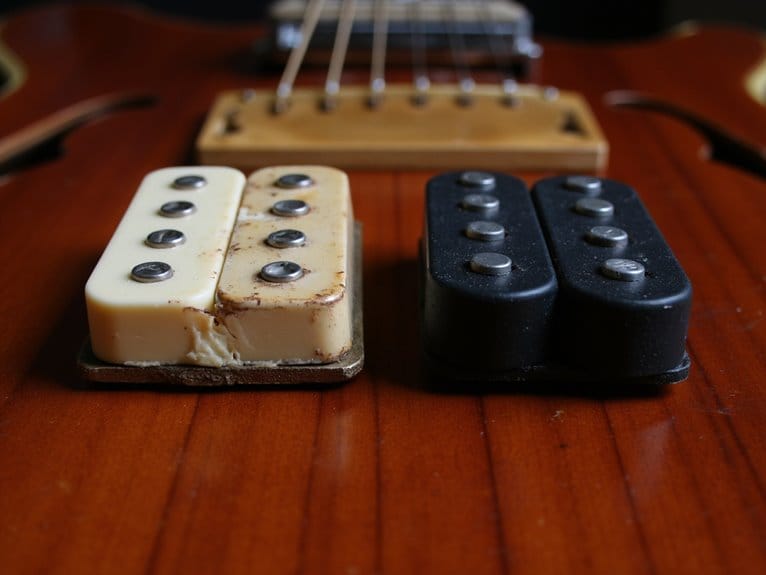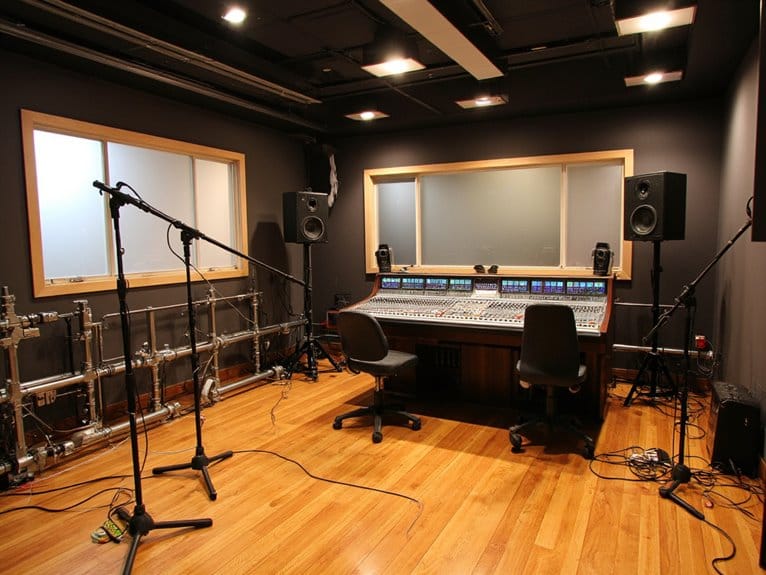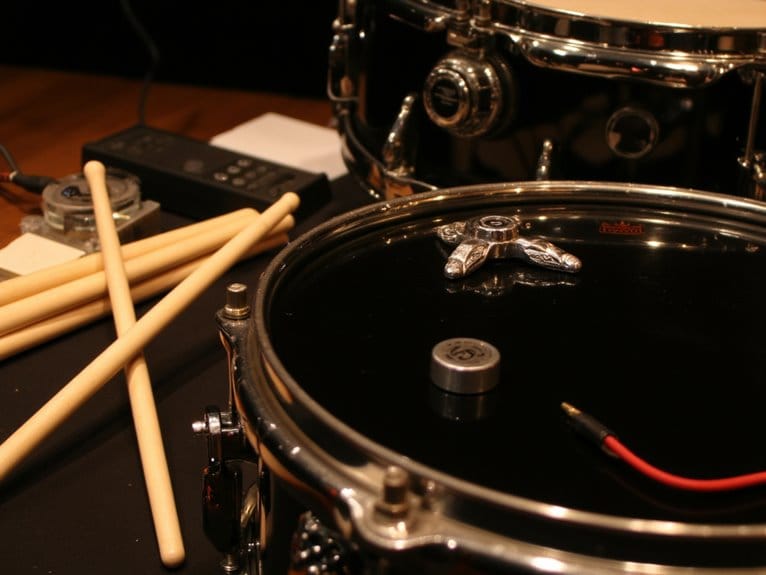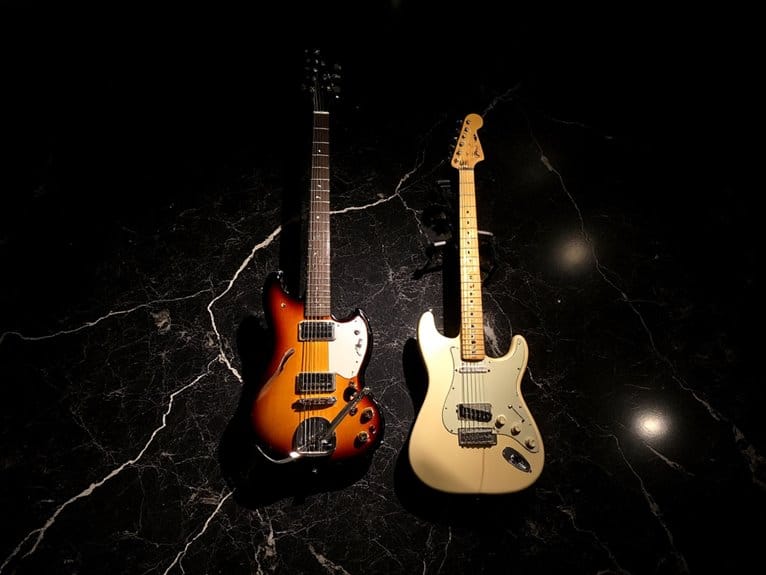Active Vs Passive Guitar Pickups: Pros and Cons
Active pickups deliver crisp, consistent tone through built-in preamps and low-impedance output, making them perfect for metal and high-gain applications, though you’ll need battery management and they cost more to maintain. Passive pickups offer warm, dynamic sound with rich harmonics that respond naturally to your playing touch, requiring zero maintenance but producing more noise in high-gain situations. Your choice depends on whether you prioritize controlled precision or organic complexity, and understanding the technical differences will help you make the right decision.
We are supported by our audience. When you purchase through links on our site, we may earn an affiliate commission, at no extra cost for you. Learn more.
Notable Insights
- Active pickups require battery power but offer low-impedance output and reduced noise, while passive pickups need no batteries but are more susceptible to interference.
- Passive pickups deliver warm, dynamic tones with rich harmonic complexity, whereas active pickups produce crisp, articulate sounds with compressed frequency response.
- Active pickups maintain consistent signal strength over long cable runs, while passive pickups may experience treble loss and impedance matching issues.
- Passive pickups require minimal maintenance and easier installation, but active pickups need regular battery replacement and more complex wiring modifications.
- Active pickups excel in metal and high-gain applications, while passive pickups are preferred for blues, classic rock, and vintage tonal characteristics.
Construction and Design Fundamentals
While both active and passive guitar pickups serve the fundamental purpose of converting string vibrations into electrical signals, their construction approaches differ dramatically in ways that’ll shape everything from your tone to your playing experience.
Passive pickups rely on traditional pickup materials like Alnico or ceramic magnets wrapped with thousands of copper wire coils, creating stronger magnetic fields that directly influence your signal strength and tonal character.
Active pickups take a different route, using fewer coil windings paired with built-in preamps powered by onboard batteries. These wiring techniques allow active systems to boost weaker signals electronically while minimizing magnetic string pull, resulting in improved sustain and intonation compared to their passive counterparts’ more magnetically aggressive approach. The low-impedance output from active pickups helps maintain signal integrity over longer cable runs and through complex effects chains.
Active pickups require a 9-volt battery to power their internal preamp circuits, which must be replaced periodically to maintain optimal performance.
Signal Output and Impedance Characteristics
The most fundamental difference between active and passive pickups lies in their signal output characteristics, where impedance levels create a cascade of effects that’ll influence everything from your tone’s clarity to how your guitar interacts with pedals and amps.
Passive pickups typically operate with high output impedance ranging from kilo-ohms to mega-ohms, while active pickups use onboard preamps to reduce impedance below 10 kilo-ohms, dramatically improving signal integrity across your entire signal chain.
This impedance difference affects your playing experience in critical ways:
- Cable freedom – Active pickups maintain consistent tone regardless of cable length
- Amplifier compatibility – Better impedance matching means reliable performance across different gear
- Noise reduction – Lower impedance translates to cleaner signals in challenging environments
The pickup configuration you choose significantly impacts your available sound palette, as single-coil setups typically deliver bright, crisp tones while dual humbucker arrangements offer greater versatility and warmth.
Active pickups are specifically designed for direct connections to mixers or amps and don’t require as much gain as passive systems, since extra gain stages can actually be counter-productive unless they genuinely enhance the signal.
Tonal Quality and Sound Performance
When you’re comparing active and passive pickups, you’ll immediately notice how dramatically different they sound, with active systems delivering that crisp, articulate clarity that cuts through dense mixes, while passive pickups offer the warm, woody resonance that’s shaped countless classic recordings.
Your choice between these tonal philosophies fundamentally comes down to whether you prefer the sterile precision and consistent frequency response of active electronics, or the organic harmonic complexity and natural string dynamics that passive magnets provide.
I’ve found that this fundamental difference in harmonic response affects everything from how your guitar sits in a band mix to how expressively you can manipulate tone through your playing technique alone.
Warmth Versus Clarity
Since I’ve spent countless hours comparing pickup tones in studios and live venues, I can tell you that the warmth versus clarity debate fundamentally shapes how your guitar voice cuts through a mix, responds to your playing dynamics, and complements specific musical genres.
Passive pickups deliver warmth dynamics through their Alnico magnets and organic response, creating that vintage sweetness you’ll hear in blues and jazz recordings. Active pickups prioritize clarity nuances with their built-in preamps, maintaining note definition even under heavy distortion.
Here’s what this means for your sound:
- Warmth feels like home – passive pickups offer expressive touch sensitivity
- Clarity cuts like a knife – active pickups slice through dense mixes effortlessly
- Your genre dictates choice – metal demands clarity, vintage rock craves warmth
The wax potting process in passive pickups eliminates microphonic feedback while contributing to those warmer tonal characteristics that vintage players seek. Active pickups maintain clarity and aggressive punch through their built-in preamps, while passive pickups generally present those warmer tones that complement vintage-inspired playing styles. Understanding the DC resistance ratings in pickups also plays a crucial role in determining output strength, with higher resistance typically yielding more aggressive character that can influence both warmth and clarity characteristics.
Harmonic Response Differences
Having analyzed harmonic response across dozens of pickup configurations, I’ve discovered that the tonal differences between active and passive pickups stem from fundamental variations in how they process and transmit harmonic frequencies, with each design philosophy creating distinctly different sonic signatures that dramatically affect your guitar’s voice.
| Pickup Type | Harmonic Character | Dynamic Response |
|---|---|---|
| Active | Compressed, uniform harmonics | Tighter control, less organic feel |
| Passive | Complex, rich overtones | Responds naturally to playing nuances |
Your passive pickups deliver genuine harmonic richness through their magnetic pull and coil design, creating organic sustain with complex overtones that react beautifully to your playing dynamics. Active pickups compress these harmonics through preamp circuitry, producing cleaner output with extended frequency response but sacrificing some natural complexity for consistency and clarity. The choice between Alnico magnets and ceramic types fundamentally shapes these harmonic characteristics, with Alnico II offering warmer overtones while ceramic magnets produce more focused tonal response. Active pickups often come with enhanced signal processing for added clarity, which fundamentally alters the raw harmonic content compared to their passive counterparts. The choice of string gauge also significantly impacts how these harmonic frequencies resonate through your pickup system, with lighter gauges enabling easier harmonic manipulation while heavier gauges provide fuller harmonic content.
Noise Reduction and Feedback Management
The eternal struggle against unwanted noise and feedback represents one of the most significant differences between active and passive pickup designs, and I’ve found that understanding these distinctions can dramatically impact your playing experience and tone quality.
Active pickups excel at noise reduction through built-in preamps that boost signals while minimizing electromagnetic interference, creating lower noise floors that resist feedback even during aggressive feedback techniques. Their low output impedance maintains signal integrity over long cables, reducing treble loss and unwanted artifacts.
Passive pickups, conversely, exhibit higher susceptibility to external noise and feedback due to their higher impedance and lack of internal buffering, particularly problematic in high-gain scenarios.
- Your volume knob adjustments won’t compromise tone consistency with active pickups
- Cable length becomes irrelevant for maintaining pristine signal quality
- Noise gates work more effectively with active systems’ stable output levels
Maintenance Requirements and Power Considerations
When you’re choosing between active and passive pickups, you’ll need to take into account the ongoing maintenance demands, particularly how battery life management affects your playing routine and budget over time.
I’ve learned through years of gigging that active pickups require consistent attention to replacement cost factors, since those 9V batteries can drain unexpectedly and leave you scrambling for spares during pivotal moments.
Your live performance reliability ultimately depends on understanding these power requirements, because while passive pickups eliminate battery concerns entirely, they introduce different factors around signal integrity and noise management that can impact your stage presence.
Battery Life Management
While passive pickups offer simplicity in their self-contained design, active pickups introduce a vital maintenance element that I’ve learned to respect over my years of playing: battery management.
You’ll need to understand how different battery types affect longevity factors, with lithium variants offering 140-240 hours compared to alkaline’s 80-130 hours. Your usage patterns directly impact replacement intervals, and I’ve found voltage testing before performances prevents mid-song failures.
Consider these emotional realities of battery dependence:
- The crushing disappointment when your tone dies during a vital solo
- Relief flooding through you after discovering easy access battery compartments
- Eco-guilt from constantly disposing batteries, though rechargeable options reduce environmental impact
Circuit troubleshooting becomes essential when experiencing rapid drain, while proper battery conservation through unplugging extends performance monitoring capabilities considerably.
Replacement Cost Factors
Beyond the immediate sticker shock you’ll encounter when shopping for pickups, I’ve discovered that replacement costs extend far deeper than the initial purchase price, creating a complex web of financial considerations that can greatly impact your long-term guitar investment.
| Cost Factor | Active Pickups | Passive Pickups |
|---|---|---|
| Hardware Cost | $150-400+ | $50-300 |
| Installation Complexity | High (routing, wiring) | Low (direct swap) |
| Maintenance Requirements | Battery replacement, preamp service | Minimal cleaning |
| Long-term Components | Batteries, clips, preamps | None |
When making cost comparisons, you’ll find that active systems demand additional wiring modifications, battery compartments, and potentially expensive cavity routing. Meanwhile, passive pickups offer straightforward installation complexity with virtually no ongoing maintenance expenses, making them considerably more budget-friendly over time despite potentially similar upfront costs.
Active pickups often include built-in preamps that require periodic servicing or replacement, adding another layer of potential expense that many players overlook during the initial decision-making process. Similar to how electronic drum sets require consideration of additional accessories for enhanced performance, guitar pickup systems may need supplementary components that add to the overall investment beyond the basic hardware purchase.
Unlike passive designs that offer reliability without power, active systems create ongoing operational dependencies that can interrupt your performance schedule and increase maintenance budgets significantly.
Live Performance Reliability
Though I’ve spent countless nights on stage watching guitarists frantically gesture to their sound engineers mid-song, I can tell you that nothing kills a performance faster than pickup reliability issues, and the fundamental difference between active and passive systems becomes crystal clear under stage lights.
Your passive pickups won’t betray you mid-solo with a dead battery, making them inherently more reliable during live soundchecks and extended sets.
However, active systems demand performance contingencies including battery backups and accessible compartments for quick swaps.
Consider these reliability factors:
- Battery failure anxiety – that sinking feeling when your signal dies
- Signal chain complexity – more components mean more potential failures
- Maintenance pressure – troubleshooting electronics between songs isn’t fun
Active pickups deliver consistent output and reduced noise throughout your signal chain, but passive systems offer bulletproof simplicity when reliability matters most.
Professional musicians often prioritize signal-to-noise ratio when choosing between pickup systems, as maintaining audio clarity becomes crucial during live amplification where stage noise and electrical interference can compromise your sound. Just as tuning stability remains crucial for string performance during extended sets, pickup consistency becomes equally vital for maintaining professional sound quality throughout demanding live performances. Similar to how professional audio monitoring requires noise isolation to block ambient sound effectively, guitar pickups must maintain consistent signal clarity despite electrical interference from stage lighting and amplification equipment.
Musical Genre Applications and Player Preferences
When I started playing guitar seriously, I quickly discovered that your choice between active and passive pickups isn’t just about technical specifications—it’s about the musical genre you’re trying to inhabit.
Pickup choice defines your musical identity more than specs—it’s about finding the voice that matches your sonic vision.
If you’re drawn to metal, hard rock, or aggressive styles, active pickups deliver the high output, clarity, and tight low-end that bands like Metallica and Slayer depend on for their signature sound.
However, if blues, jazz, or classic rock appeals to you, passive pickups offer the warmth, dynamic response, and tonal complexity that these genres demand.
Your player preferences ultimately determine which system serves you best—whether you prioritize the clinical precision of actives or the organic expressiveness of passives.
For players exploring extended range instruments, dual humbucker setups with high-output pickups are particularly ideal for metal genres, providing the aggressive tone needed for lower tunings and heavier playing styles.
Frequently Asked Questions
Can You Mix Active and Passive Pickups on the Same Guitar?
You can mix active and passive pickups, but pickup compatibility issues arise from different impedances and potentiometer requirements. Expect tonal differences and complex wiring modifications. Most guitarists prefer sticking to one type for simplicity.
How Long Do Active Pickup Batteries Typically Last Before Replacement?
Battery life for your active pickups typically ranges from 80-240 hours of playing time. Replacement frequency depends on your usage habits – you’ll need new batteries every 6-18 months with regular unplugging extending lifespan considerably.
Do Active Pickups Work Without Batteries or Power Source?
You can’t use active pickups without batteries since they have strict power requirements for their preamp circuitry. Without power, you’ll get no signal output or extremely weak, unusable sound from your guitar.
On a final note
You’ll find that choosing between active and passive pickups ultimately depends on your playing style, musical preferences, and practical needs. If you’re seeking traditional warmth with minimal maintenance, passives offer proven reliability, while actives deliver consistent output with enhanced versatility at the cost of battery dependency. Consider your genre requirements, budget constraints, and willingness to manage power needs when making this essential decision for your guitar setup.






